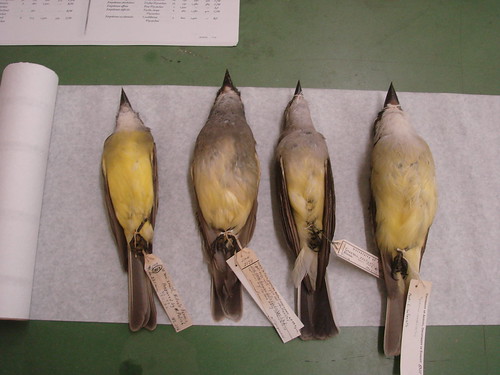I'm out in the field in SE Arizona and spot a small group of birds on the fence. I easily identify them as one of the yellow-bellied kingbirds. It's not Couch's because there's only one record in AZ for those (and yes, I am realistic in my sightings and don't expect to see a super rare bird!). That brings up four contenders: Thick-billed, Tropical, Western, and Cassin's.
Thick-billed is out because (unlike other bird names that I know, for example Red-cockaded woodpecker--just who can see the red cockade in the field?) this name actually fits and the bird really does have a thick bill (and, of couse, it's really rare--note my attitude toward seeing rare birds above).
So now I'm down to three. Tail color of Tropical, being brown rather than black, means that these birds are not a Tropical. That leaves Western and Cassin's, which are frustrating. Now, if you had one of each side by side (as in the field guides) you can see a difference in the darkness of the gray on the chest; but such contrastive criteria really don't work when I am faced with a single specimen. (Field Guides, for example, don't take in the individual variation: how about a very light Cassin's next to a very dark Western's?)
The other day I admit I got pretty annoyed. However, this caused me to spend some time with photos of dead birds (and contrary to dead puppies, dead birds are much fun--as long as they weren't killed by cats) and have finally understood a helpful difference.
Cassin's Kingbirds are fatter. Yes, in part, in the picture below this is an artefact of preparation, but it really is true in the field. Cassin's Kingbirds are chubby and thus their centre of gravity is in their belly and--most helpful of all--they sit very close to the wire: they seem almost to sag a bit. Westerns, on the other hand, are sleeker and more figure-conscious: they are all-over slimmer and their centre of gravity appears to be more in the chest causing them to sit in a more upright position (more space between the wire and their body mass).
This is the picture that helped me out--you can really see the difference in bills as well as the color contrasts--again, if I had had a nice row of kingbirds in the field, I might have been able to distinguish them quickly too!
Thick-billed is clearly the bird on the right, Tropical is clearly the bird on the left. In the middle, then, are my two nemeses. But the left of the two is fatter--his belly is rather large and he appears not to have a neck, so this should be a Cassin's. And it is--now I look at the coloring. That makes the third bird from the left a Western.
When I returned to the field guide, I saw that the specific epithet of Western Kingbird is verticalis. For all those folks who think Latin is a dead language, I have to say that it sure helped me here. It makes sense! Western Kingbird is vertical on the wire.
Here's a photo that shows the vertical stance well:
Next week, I'm devoting time to peeps.....till then happy birding!
Subscribe to:
Post Comments (Atom)



Another excellent post Alison. The Western Kingbird also has distinctive white edges on their tail.
ReplyDeleteI am waiting for your post on Empidonax Flycatchers. I could really use some tips on telling them apart! :-)